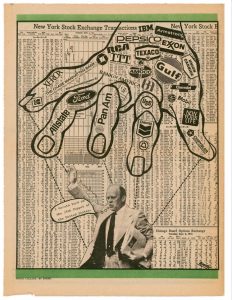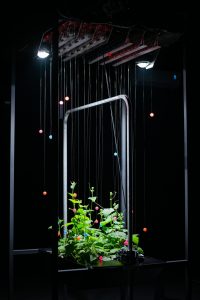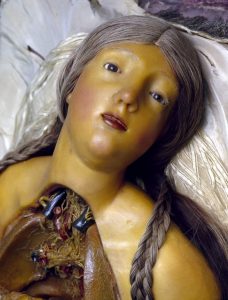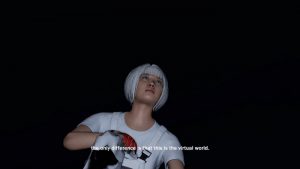LABoral, the art center we have come to associated with new media art, has recently opened an exhibition dedicated to new, audacious and thought-provoking forms of design. Curated by Roberto Feo and Rosario Hurtado (El Último Grito), Nowhere/Now/Here aims to challenge the perception of design by questioning our relationship with the environment. Taking the viewpoint that our environment has become part of us rather than us being part of it, as its point of departure, Nowhere/Now/ Here encourages us to see design as an integral component of the world-shaping process.
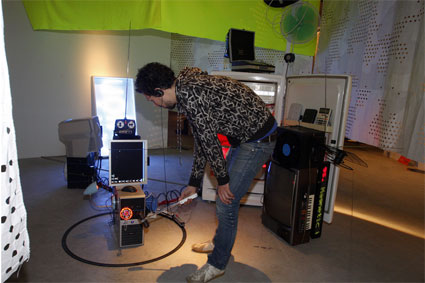 Troika. Gijón Magnética. 2008 (foto Enrique G. Cardenas)
Troika. Gijón Magnética. 2008 (foto Enrique G. Cardenas)
Nowhere/Now/Here features more than 60 works that challenge the conception we might have of design. Some by designers you may have met in these pages before (Dunne & Raby, Troika, Auger-Loizeau, Eelko Moorer, David Bowen, Pablo Valbuena, Marei Wollersberger, Yuri Suzuki, Noam Toran, etc. ) and in many other publications (Tord Boontje, Assa Ashuach, Paul Cocksedge, etc.)
The design of the exhibition itself reflects the explorative approach of Nowhere/Now/Here. Conceived like a ‘mental adventure’ and relying on colourful graphics on the floor that guide visitors through the space, it was created by Patricia Urquiola studio and the graphic image and vision of Fernando Gutierrez.
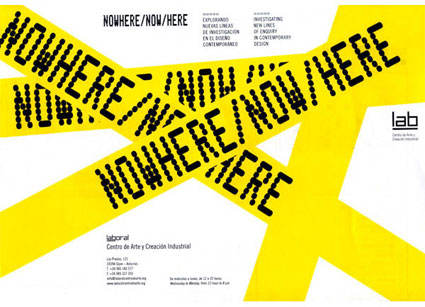
The catalogue of the the exhibition Nowhere/Now/Here, Investigating New Lines of Enquiry in Contemporary Design is gorgeous and its cast is stellar: there are interview with Ron Arad, Javier Mariscal and other important figures of design, essays by Marti Guixe, Santiago Cirugeda, Matt Ward, Dunne & Raby, a description of all the participating projects, loads of photos and beautiful graphics. Almost 300 pages, in both spanish and english for a mere 35 euros. The online shop of LABoral seems to be a bit under the water these days, so until the situation is fixed, the easiest way to get your hands on the precious volume is to write LABoral and ask if they can send you a copy.
The curators of the exhibition are Roberto Feo and Rosario Hurtado. Ever since they founded El Último Grito back in 1997, the designers have kept away from preconceived definitions and prescribed design paths. A perspective that didn’t prevent them from teaching at the most prestigious colleges of design and working for renowned companies and institutions: Mathmos, Selfridges, the Victoria and Albert Museum in London, Lavazza, Budweiser, Style, Metalarte, Hugo Boss, Southwark Council, Arturo Alvarez, the Lighthouse, etc.
I caught up with the Berlin/London-based duo to discuss Nowhere/Now/Here:
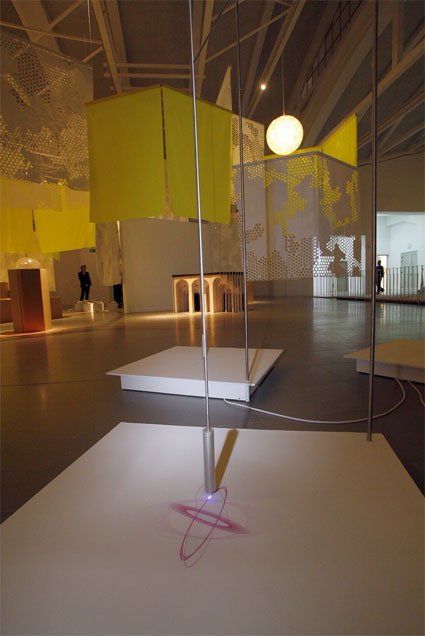 Random international. Pendulum Lights.2008 (photo Enrique G. Cardenas)
Random international. Pendulum Lights.2008 (photo Enrique G. Cardenas)
How did El Último Grito land on the LABoral spaceship? How did two famous designers end up curating an exhibition ‘that challenges the perception of design by questioning our relationship with the environment. Taking the viewpoint that our environment has become part of us rather than us being part of it, as its point of departure, Nowhere/Now/ Here encourages us to see design as an integral component of the world-shaping process’ ?
Was it a request that came from laboral or your own initiative?
LABoral contacted us to curate and exhibition on ‘experimental design’ (what ever that means) so for us it was a question of trying to define what experimental meant to us.
We explored different areas of work and try to define a strategic approach for each of them, which lead designers to challenging design’s status quo. We identify three basic areas with their accompanying strategies
Material_Intervention: projects that explore material innovation and new material applications, new production techniques, technology, genetic engineering, graffiti,…
Cultural_Resistance: Projects and designers that position themselves in confrontation with the dominant culture, both in terms of the design outcomes, but also in terms of practice within the culture of design.
Psychological_Exploration: projects that analyse the psychological and sensorial experience of the object or that act as triggers of emotions and sensations. And psychological objects that carry the essence of the psychological experience.
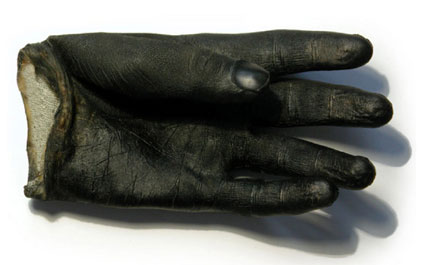 Dominique Wilcox, the Glove
Dominique Wilcox, the Glove
This worked for us as a starting point, which provided us a basic structure to classify the researched works. But for us it became apparent that were many other connections between the works, and that such a classification would not allow you to understand. When we started recombining the works in a more intuitive way, for us suggested conceptual connections between really different areas of work. We also felt that this allowed the viewer to find his or her own entry points into the exhibition.
Our intent was to present a collection of objects that would allow you to understand the thinking process of the artists behind them. Presenting them as thinkers who can not only reshape their own particular worlds but that show the potential to transform, re-interpret and re-think industries, production processes, communication strategies, political systems, etc. Challenging our preconceptions of what design can do.
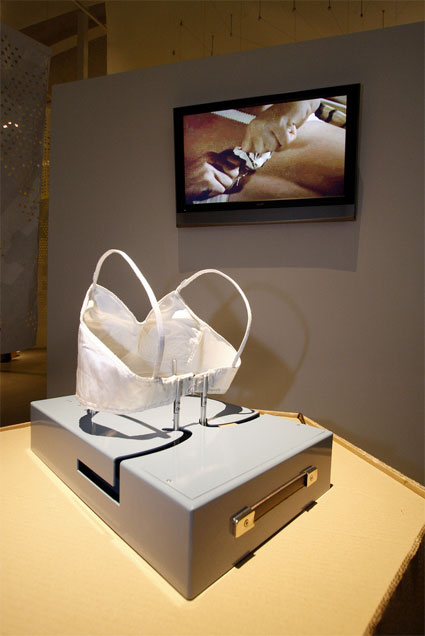 Noam Toran & Nick Williamson. Bra Machine. 2007 (foto Enrique G. Cardenas)
Noam Toran & Nick Williamson. Bra Machine. 2007 (foto Enrique G. Cardenas)
What did this curatorial experience teach you?
It has been a very interesting experience. It has given us the chance (or luxury) to dedicate proper time to lo closely to the work of many other peoples, to understand their motivations and their intentions. And interpret them in relation to each other (including our own work). Creating a bigger pictured that talked about the fantastic potential and diversity of design approaches.
That it’s why we treated the exhibition as a project itself, rather of plain review of design today. So in a way is not so much an exhibition on experimental design as much as an experimental exhibition on design. We wanted to create a moment where different aspects of design would collide in a space and something would come up from this experiment. Which in a way has already happened among the participating artists and designers, in terms of friendships and collaborations. But above all, the most incredible feeling is one of ‘togetherness’ and true interest in each others work, which has become unusual in such competitive world. This is very uplifting and makes us believe that something major is happening within the design world.
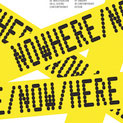 Also, it was very interesting to work on the edition of the catalogue, in which we collaborated intensively with Fernando Gutierrez who carried out its design. In a way the catalogue becomes almost more important than the exhibition itself, they have a life beyond the exhibition, so we wanted that the catalogue would be a space that you travel like the exhibition. It follows the same structure of the show, with the works presented according to the six groups created from word associations that connect to the works in an intuitive way:
Also, it was very interesting to work on the edition of the catalogue, in which we collaborated intensively with Fernando Gutierrez who carried out its design. In a way the catalogue becomes almost more important than the exhibition itself, they have a life beyond the exhibition, so we wanted that the catalogue would be a space that you travel like the exhibition. It follows the same structure of the show, with the works presented according to the six groups created from word associations that connect to the works in an intuitive way:
TYPOLOGY / MUNDANE / ANECDOTE / FICTION / MYTH
SOLIPSISM / EXPANSION / REVEAL / AUGMENTATION
ASSEMBLAGE / ABSORB / DIALOGUE / SUBVERT
LOSS / ABSENCE / TRACE / THE UNSEEN / IDENTITY
SYSTEM / MORPHOLOGY / RECONFIGURE / SYMBIOSIS
SOLITUDE / THE ONE / THE SELF / MEMENTO
The works, texts and interviews have been grouped in order to create moments. Images and stories for the visitor/reader to find their own point of access to the ideas around the works. Very much following the idea of a ‘trafalmadorian’ book, from Kurt Vonnegut’s Slaughterhouse V:
“Billy couldn’t read Trafalmadorian, of course, but he could al least see how the books were laid out- in brief clumps of symbols separated by stars. Billy commented that the clumps might be telegrams. “Exactly”, said the voice. “They are telegrams?” “There are no telegrams on Trafalmadore. But you’re right: each clump of symbols is a brief, urgent message-describing a situation, a scene. We Trafalmadorians read them all at once, not one after the other. There isn’t any particular relationship between all the messages, except that the author has chosen them carefully, so that, when seen all at once, they produce an image of life that is beautiful and surprising and deep. There is no beginning, no middle, no end, no suspense, no moral, no causes, no effects. What we love in our books are the depths of many marvelous moments seen all at one time.”
The catalogue is an assemblage of works, described by the designers and artists, essays from some of the participating artists, which although often linked to personal projects, are surprisingly useful to understand everyone else’s work, and interviews to four of our all time heroes: Ron Arad, Javier Mariscal, Daniel Weil and Gaetano Pesce; which contextualise the work of this younger generation of designers.
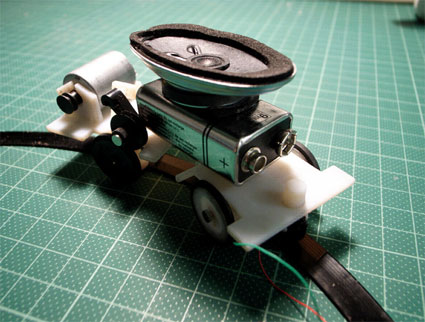 Yuri Suzuki, Sound Jewellery
Yuri Suzuki, Sound Jewellery
You didn’t seem to have selected any of your own works for the show. Why not? And if i asked you to point us to the work you developed that best reflects the theme of the exhibition, which one would it be?
Well, for us the exhibition itself is a piece of work, a project that is the result of the collaboration with everybody involved, from the LABoral team, to all the artists, writers and advisors.
There are two video projects that we feel worked well within the themes of NOWHERE/NOW/HERE.
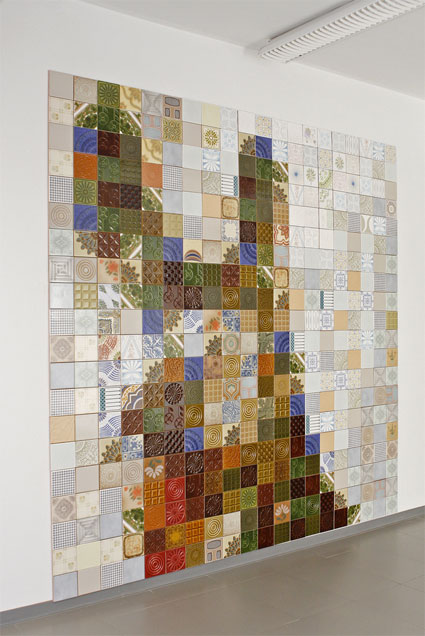 Pedrita. Dog. 2007 (photo Enrique G. Cardenas)
Pedrita. Dog. 2007 (photo Enrique G. Cardenas)
One is ‘LINE’ which is a video consisting of a horizontal line where words appearing above and bellow. As the words change, your interpretation of what the line is also changes, and as you keep watching you find yourself adjusting your interpretation of the space and the way of seeing it. This is one of the three pieces, dealing with the idea of perception, which we have used as an introduction to the show. There other two are Grao by Pedrita, which reproduces a photographic image using traditional untreated ceramic tiles, to substitute the pixels of the image; and Marc Owens ‘Avatar’ film, which he reshot as a walkthrough the exhibition, the piece is fantastic as it is always playing with how you perceive reality.
Nowasteeur
The other video is ‘NOWASTEEUR, a laborious poem’. This video is a new direction in terms of documenting our work. We started using video to try to document our installations, as we felt that just by keeping a photographic record of the event, did not reflect our ideas about the nature of the work that we call ‘design performance, performing design’. But then we realised that the video itself could even had another narrative which would give it an identity of its own and not just being a document of the work. ‘NOWASTEEUR, a laborious poem’ was conceived as part of a public sitting commission during ARCO at IFEMA. The idea was to utilise all the packaging materials that are thrown away during the setting up of the fair. We came out with the idea of big bags in the shape of letters that would be filled up with all the waste materials. NOWASTEEUR are the ten letters that you need to write NO WASTE and RE-USE which was the main message that we wanted to put across. After that we elaborated a short poem using those letters (plus M which you get out of turning around the W), which you see forming in the video while all the action of the installation is being recorded:
NO WASTE_RE USE_ANSWER ME_NOT US_USER WON’T_WEST_EAST_RAW WAR_NOTE RUSE_USE ART_STEM NEW_SOME ONE TO STEER_SURE MUST EASE TEARS_MEET TEAM NOW_USE _RE-USE_WASTE NOT.
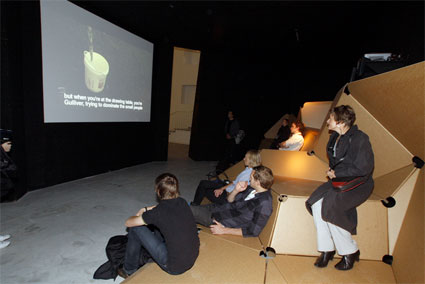 Nic Rysenbry. LandSpace.2008 (foto Enrique G. Cardenas)
Nic Rysenbry. LandSpace.2008 (foto Enrique G. Cardenas)
‘NOWASTEEUR, a laborious poem’ is shown as part of the film program, which runs at the exhibition’s design cinema (the cinema sitting is a commissioned piece by Nic Rysenbry)
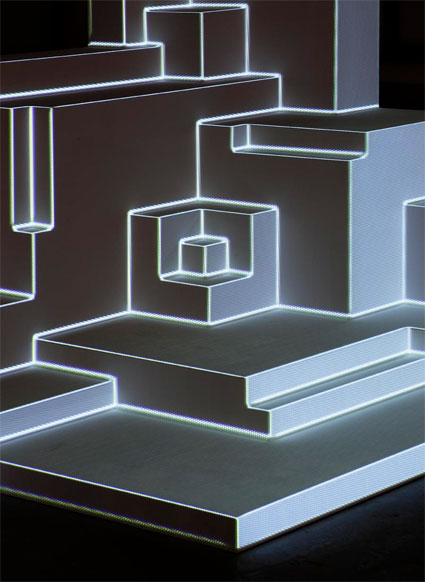 Pablo Valbuena’s Augmented Sculpture. Photo: © LABoral – Author Marcos Morilla
Pablo Valbuena’s Augmented Sculpture. Photo: © LABoral – Author Marcos Morilla
David Bowen‘s Remote Sonar Drawing Device, and Pablo Valbuena‘s installation Augmented Sculpture Series, have been exhibited in the past in purely artistic contexts. What made you think that they fitted the exhibition’s objective to ‘encourages us to see design as an integral component of the world-shaping process’?
Design is an integral component of the world-shaping process. Only because design takes many forms, sometimes we ‘can’t see the forest from the trees’.
In NOWHERE/NOW/HERE we tried to investigate (like the sub title says) ‘new lines of enquiry in contemporary design’. Showing a diversity of work, which presented the different ideas and directions that designers are exploring today.
In the case of David Bowen, we find really interesting his work, where both technological research, and robotics collide with the questioning of the nature of drawing. His design translates movement into drawing. He has deliberately chosen make his machine draw ‘marks’ (like young children when they start drawing and are just interested in leaving their mark) by translating the movement recorded into impulses, which connect with the idea of representation, so central to the idea of drawing. So in fact, is that drawing purely a mark or is it a representation of the circulation of people? Is that drawing artistic or scientific? Is it both? But it not only raises questions in the nature of drawing as a human activity but in the nature of technological research and its applications.
In the exhibition his piece is in conversation with by Javier Mariscal’s hand made wooden drawing of a ‘VESPA’ (2007), one of the surprise little homage’s to the ‘maestros’ object of the interviews in the catalogue.
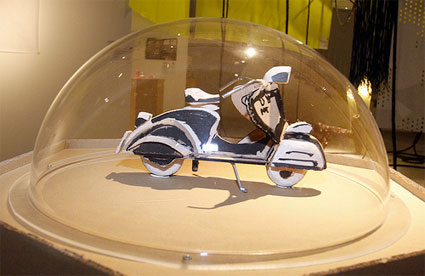 Javier Mariscal (foto Enrique G. Cardenas)
Javier Mariscal (foto Enrique G. Cardenas)
With Pablo Valbuena, we saw his work at ARCO and we fell in love with it instantly. The way he uses light and video to transform the perception of space and the materiality of the build, it is simply fantastic. In his case, it is obvious that the content of his work comes directly from his training as an architect, and his research into the qualities of space. So his work is very much design, but its materialization and dissemination is through the art market.
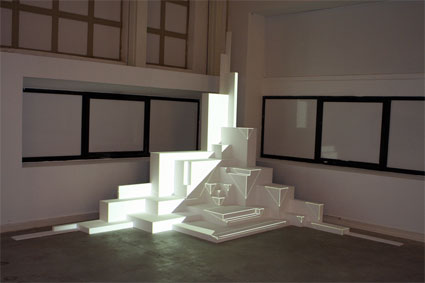 Pablo Valbuena.Augmented Sculpture Series. 2008 (photo Enrique G. Cardenas)
Pablo Valbuena.Augmented Sculpture Series. 2008 (photo Enrique G. Cardenas)
These two pieces, like indeed many others within the exhibition are providing a different point of view on how thing are around us. This helps us understand that there is always more than one answer and that by no means we should accept what the market or the designer or the politician or religion or science tell us. There are always alternatives. Most things are not the way they are because of some force of nature that is beyond our control. Things are the way they are because someone decided at one moment that this or that was a good idea, or make them lots of money or be good for humanity or the environment or … there are no ultimate truths, just proposals that became ‘real’ and these could and do change.
In the catalogue we refer to Martin Scorsese’s film The Departed quoting Frank Costello, the mob boss, who while describing his neighbourhood says ‘I do not want to be a product of my environment, I wasn’t my environment to be a product of me’. For us this has a resonance within design and acts as a reminder that it is possible to change the rules of the game.
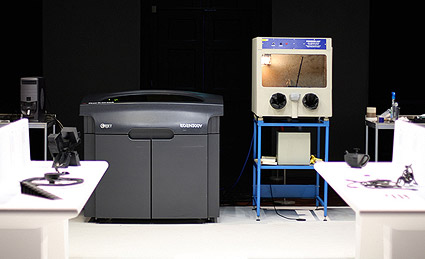 The MacGuffin Library (Photo: Gunnar Green)
The MacGuffin Library (Photo: Gunnar Green)
On the other hand some of the works selected openly dialog with the art world (for example The Macguffin Library and cinema). Which are the characteristics that indicate that these works belong strictly to the field of design and not art? And is the difference always strict anyway? Or is there a conscious desire to keep the boundaries as porous as befits the purpose?
We guess that the answer would be in how do you define each one of them. From our point of view everything is design.
A few weeks ago we read a short interview with Vito Acconci where he was asked a similar question regarding the design/art argument and he was saying that a big part of the problem came from the fact that ‘art’ is the only discipline that is defined by a qualitative appreciation. We share that point of view and we think that the word art would have to be left for any kind of work that excels in whatever area of human activity. Who is to say that the work of Ferran Adria is less art than that of Jeff Koons? Or that a Frank Lloyd Wright building is less or art than an Andreas Gurski photograph? Or that Leonardo’s flying machines is less art than his Monalisa?… What are the grounds for comparison and how or why would you do it? This is the eternal argument, from our point of view is easier as we see no boundaries. Maybe this interpretation of design might be confusing or unacceptable for some people who do have a very clear idea of the boundaries of between the two.
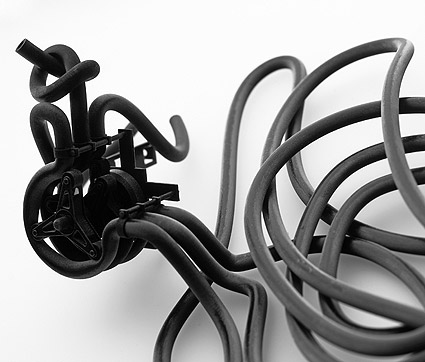 The MacGuffin Library, Civilian fantasy machine (Photo: Sylvain Deleu)
The MacGuffin Library, Civilian fantasy machine (Photo: Sylvain Deleu)
The ‘McGuffin Library Collection’ by Noam Toran and Onkar Kular obviously lives in the edges of what is traditionally accepted as design, and I guess it raise questions in both directions. As they explain, McGuffin is a term invented by Alfred Hitchcock to define an object within a film, which somehow acts as a devise to carry the narrative of the story. In terms of the story, the design of this object becomes, so its conception is a design exercise on its own. For Onkar and Noam this works perfectly well to explore further their ideas around the use of design as a medium that is central to their work. In this case they wrote 14 synopsis for imaginary films for which they designed an object. These objects are primarily talking about the role of objects as mediators in our understanding of the world (in this case of the story). In a second layer, they are talking about the world of technology, production and design. The objects are produced in rapid form directly from 3D computer models. The objects are not unique necessarily unique as they are printed very much like you would do with a computer document. Is that a banal use of technology, design and engineering just because thy are not pursuing ‘the grater good’ or the commercial enterprise? Would that make it art? For us what makes them good design and good art is exactly the same thing, they are able to broaden and challenge our preconceived ideas of what things are, while being moving and engaging.
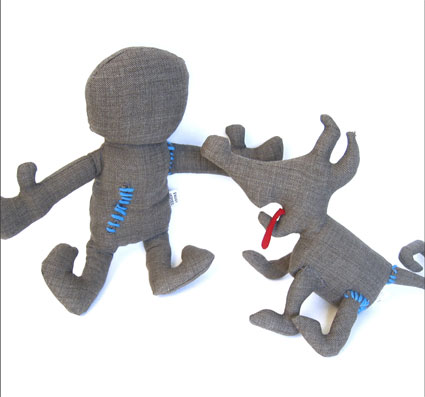 Mathias Hahn‘s Imperfect Dolls
Mathias Hahn‘s Imperfect Dolls
Most of the works exhibited in Nowhere/now/here come from Europe. Is that a curatorial choice or is it merely because this way to engage with objects is still confined to our continent?
It was not a particular curatorial choice. We tried to select people and works that we found interesting and that helped us illustrate the ideas behind NOWHERE/NOW/HERE. It is true though, that still Europe is the main centre for design in the world, with some of the most prestigious and influential design schools in the world (RCA, Eindhoven, Domus,…) so it is unavoidable that a lot of the designers (although not necessarily European themselves) who are doing interesting work would come from them.
Like with any other project there are many reasons that contribute to the final decisions and results (most of them are usually quite mundane)
For NOWHERE/NOW/HERE we tried to work with people with whom, despite working in very different areas, we found an affinity and a complicity in pushing the boundaries of what is accepted in design.
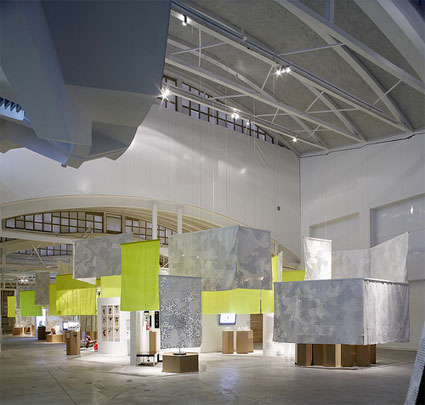 Photo: © LABoral – Author Marcos Morilla
Photo: © LABoral – Author Marcos Morilla
Why did you ask Patricia Urquiola to take care of the exhibition design? Why not do it yourself? Did you hand her a list of requirements or did you give her carte blanche? How much did you collaborate and how did her vision of the exhibition influence yours?
We did not want to do the exhibition design for the same reasons that we did not really wanted to show our work. It just did not made sense to us to be curators, exhibitors and exhibition designers, for this we could have just done an exhibition of our work. But at the same time is hard being a designer yourself to surrender control to someone else, but in the other hand it brings an unknown element into play which we think adds to the whole process.
With Patricia Urquiola and Martino Berghinz we were very lucky that we could take advantage of their relationship with LABoral, and were very happy when they decided to participate in the project.
We always had the idea that whoever did the exhibition design we would like it to be or feel like one more piece in the exhibition. So our brief was very open, we showed them the six groups of works which we had assembled and asked them to give us six permeable spaces where you could experience the groups as a one thing and at the same time you would be aware or attracted to the works of the other groups, so that the visitor could break away from the structure and find their own way to navigate the show.
Their response was to create a laberynthic exhibition space that creates many small private moments. It broke our idea of being able to experience each group as a whole, but in the other hand, it work very well in the sense that allows you to find your own experience of the show. So we totally respected their proposal and change the concept and create smaller relationships within the pieces rather that the group encounter. For us was important not to step in and allow these and other inputs take their course
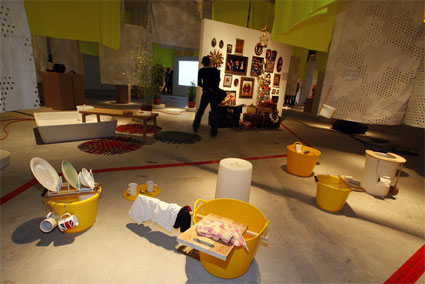 Carl Clerkin. Desperate Measures. 2008 (photo Enrique G. Cardenas)
Carl Clerkin. Desperate Measures. 2008 (photo Enrique G. Cardenas)
And how much do you feel that her intervention reflects the spirit of the exhibition, making it maybe another work in itself that does belong to the show?
We think that their idea of dividing the space from the top by hanging fabrics its a very spatial (and material efficient) solution that multiplies the space by creating a very atmospheric cloud of mini spaces which are all inter-connected.
You are both lecturers in London, Roberto teaches Design Product at the Royal College of Art and Rosario at the Design Department, Goldsmiths College. How much does your teaching practice reflect the concepts and ideas put forward in the exhibition? And more importantly which kind of career awaits students who might want to follow the paths of the designers you’ve invited to the exhibition? Will they end up working exclusively in the hope that their projects will be shown in art galleries and museums or does the industry realize there is a real need of such visions and will companies therefore welcome them with open arms?
As you mentioned, we have been lecturers at the Royal College of Art and Goldsmith University for the last 10 years, and we are also Research Fellows at Kingston University. For us this experience is central to the development of our own ideas and to understand the concerns and ambitions of new generations of designers.
We would like that the works in NW/N/H are viewed not as the object that you can see at the exhibition, but as the potential that these designers have to translate their knowledge and skill into different outcomes. How these objects are the products of inquisitive minds that give nothing for granted but are also responsible and very thorough in the development of their work.
Many of the designers invited to the exhibition are very successful and work across industries, what they have in common is a non-conformist approach to their practices. These designers are changing the scope of the design practice, elaborating new industries and opening new areas of work. Some of the younger designers are still starting to navigate their way but surly in years to come they will be some of the leading figures in art or design or design-art or art-design or science or film…
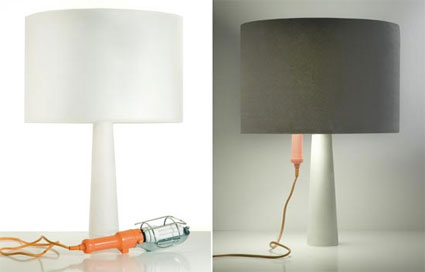 Cau table lamp by Marti Guixé
Cau table lamp by Marti Guixé
At the end the question of where some work lives is purely economical. Today there are more possibilities for designers to find means of commercialisation and dissemination of their work through galleries and exhibitions rather than through the mass market. We have to be aware of the changes to the market and to the industry that we have experience in the last years. And industry is falling behind in attracting talent because it is hard for them to react to new ideas.
We have always worked between the experimental and the commercial, the two running parallel and feeding from each other. This self-feeding process has always been part of our work and we think has enriched it (but we are ‘old school’ now) and the way we work (or even our drivers) are very different to how our students perceived design today or the kind of work they want to do.
We hope that industry reacts (what ever industry) and tries to be again a leading force in research and creativity. At the end of the day what will determine which avenue designers will follow, or where their work will be show cased is a question of market opportunities and ultimately their cultural influence. At the Design Museum tomorrow, at the V&A in a couple of decade or at the British Museum in a few centuries.
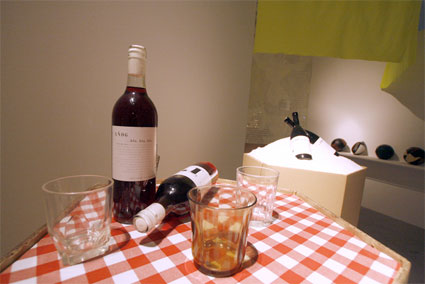 Marta Botas & Germán R. Blanco. Rara de raro. 2006 actualidad (foto Enrique G. Cardenas)
Marta Botas & Germán R. Blanco. Rara de raro. 2006 actualidad (foto Enrique G. Cardenas)
Do you see design meccas like the Salone del Mobile in Milan open up to this kind of discourse?
We do not see why not. There have been times where companies would champion new concepts and ideas. Seeing how markets are evolving industry will have to react and accept that cannot just be playing to an outdated lifestyle ideal.
In Milan you can see lots of the things that are going on right now, but it is hard to see with more than 300 exhibitions in the ‘fuori salone’. How would we even know that its even there? In any case, for good or bad, there are many new ways of disseminating design much more economical and accessible.
 Toypography, by Dainippon Type Organization
Toypography, by Dainippon Type Organization
Is El Ultimo Grito already working on new projects? Could you share them with us?
We are working in a book about our work, which we are looking to publish sometime in April. Apart of our usual combination of self initiated projects and commercial ones, some of which will be presented in Milan next April. A bit of everything, like always.
Thanks Roberto and Rosario!
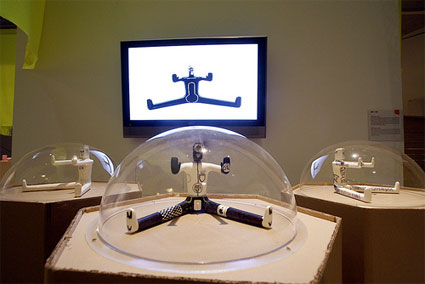 Dunne & Raby. Evidence Dolls (foto Enrique G. Cardenas)
Dunne & Raby. Evidence Dolls (foto Enrique G. Cardenas)
Nowhere/Now/Here runs until Mon, April 20 , 2009 at LABoral Centro de Arte y Creación Industrial in Gijon, Spain.
Image on the homepage: Daniel Charny & Gabriel Klasmer. Sports Furniture.2008, based on a photo version from 2003 (photo Enrique G. Cardenas)
Related stories: If you can’t travel to Gijon (there are direct flights from London), i would encourage you to visit Wouldn’t It be Nice at Somerset House where some of the designers are exhibiting their works until December 14, 2008.
Designing Critical Design – Part 1: Jurgen Bey, Designing Critical Design – Part 2: Marti Guixé and Dunne & Raby, Work in progress show at RCA: Platform 11 (design products), Tony Dunne – Design for Debate, etc.

